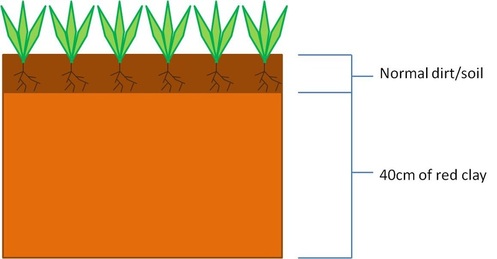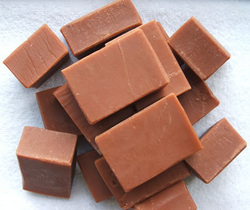Mostly tree-proof soil...
Savannas recieve nough rain every year for a tree to grow but why can't most trees survive in the savannas? This is all because of the soil. Beneath the surface of the ground, there is a 40cm thick layer of red clay which prevents most trees from planting their roots and growing.
The diagram above shows that grasses are suitable to plant their roots. However, many trees have much thicker, and larger roots making it harder for them to plant their roots into the soil.
The diagram above shows that grasses are suitable to plant their roots. However, many trees have much thicker, and larger roots making it harder for them to plant their roots into the soil.
Some people use red clay from the savannas to make soap and even put it on their skin to enhance their skin texture and condition.
Nutrients and enrichening
The soils of the savanna are enriched throughout the year. During the rainy seasons, the rain and/or floods will replenish the land while during the dry seasons, and the fires will enrich the soil. How does the fire enrich the soil? Well, when a bush fire starts, it burns many plants down and decomposes them at rapid speed. The plants become ash and return to the soil and adds nutrients to the ground. However, in some populated grasslands, the locals put out the fire, making it hard for the soil to become rich in nutrients.
Another way nutrients are added to the soil is through a type of bacteria called 'cyano bacteria'. They add nutrients to the soil by pulling nitrogen out of the air and then turning it into ammonia (NH₃), nitrites (NO₂) and nitrates (NO₃) which then the plants can absorb and use as food.
Urease is an enzyme which is found in soils of savannas. It replenishes the soil with nitrogen. They break up animal urine called urea and turn it into ammonia, which contains nitrogen and also hydrogen.
Another way nutrients are added to the soil is through a type of bacteria called 'cyano bacteria'. They add nutrients to the soil by pulling nitrogen out of the air and then turning it into ammonia (NH₃), nitrites (NO₂) and nitrates (NO₃) which then the plants can absorb and use as food.
Urease is an enzyme which is found in soils of savannas. It replenishes the soil with nitrogen. They break up animal urine called urea and turn it into ammonia, which contains nitrogen and also hydrogen.


